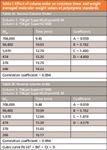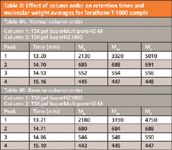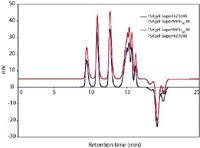Which GPC Column First?
In the recently published 2nd edition of Modern Size Exclusion Liquid Chromatography: Practice of Gel Permeation and Gel Filtration Chromatography (1) it is stated that the debate about which column to place first when running a series of SEC columns is still open.
Bruce Kempf, Tosoh Bioscience, LLC
In the recently published 2nd edition of Modern Size Exclusion Liquid Chromatography: Practice of Gel Permeation and Gel Filtration Chromatography (1) it is stated that the debate about which column to place first when running a series of SEC columns is still open. This is despite most manufacturers' recommendation of installing the columns in order of decreasing pore size, the largest pore size column connected to the injector and the smallest to the detector. Scientists at Tosoh Bioscience tested the validity of this recommendation using 4.6 mm ID × 15 cm TSK-GEL® GPC columns optimized for high speed analysis on the EcoSEC® GPC System.
In order to make the experiment as sensitive as possible to the effects of the order in which the sample encounters small versus large pores, two columns with 3 and 4 μm particles that differ vastly in pore size and pore size distribution were chosen. The small pore column used was the TSKgel® SuperHZ1000 column with a mean pore size of 15Å and narrow pore size distribution. The large pore size column used was the TSKgel SuperMultiporeHZ-M with a mean pore size ca. of 800Å and a wide pore size distribution. It is reasoned that if there isn't any difference with these high resolution columns, there should not be any column arrangement differences for any two columns that have lower resolution.
When coupling the two columns in series, the TSKgel SuperHZ1000 column is either placed before or after the TSKgel SuperMultiporeHZ-M column. Using commercially available polymer standards, molecular weight averages were determined to see if the question of whether it is better to place the small pore column first or last could be answered.
Materials and Methods
Instrumentation: EcoSEC GPC System (Tosoh)
Data Processing: EcoSEC-WS (Tosoh)
Columns: TSKgel SuperMultiporeHZ-M, 4 μm, 4.6 mm ID × 15 cm TSKgel SuperHZ1000, 3 μm, 4.6 mm ID × 15 cm
Mobile Phase: THF
Flow rate: 0.35 mL/min
Detection: RI
Temperature: 40 °C
Injection vol.: 10 μL
Samples: PStQuick MP-M polystyrene standards varying in MW from 500 to 706,000 Da (Tosoh Bioscience) Terathane® poly(tetramethylene ether glycol) T-1000 (Aldrich Chemical)
Concentration: ~1 mg/mL in THF
Results
The objective of this study was to determine and compare the average molecular mass values of polymer standards using two columns in series when operating these columns in normal and reverse order. For the purpose of this study, the "normal" order was arbitrarily defined as the one in which the largest pore size column was connected to the injector, followed by the smallest pore size column, which was connected to the detector.

Table I: Effect of column order on retention times and weight averaged molecular weight values of polystyrene standards
Table I shows the Mw values of six polymer standards and their retention times and correlation coefficients for a cubic fit to the curve connecting the retention times, while Table II shows retention times and calculated Mn, Mw, and Mz values for four distinct components in T-1000 PTMEG [poly(tetramethylene ether glycol)] polymer. The order in which the columns were installed in the EcoSEC GPC System is listed above each table. In all cases, column 1 is attached to the injector, while column 2 is connected to the detector.

Table II: Effect of column order on retention times and molecular weight averages for Terathane T-1000 sample
Discussion
Table I lists the coefficients of variation obtained by fitting the retention of six polymer standards to a cubic equation for each of the column arrangements. Table IA (normal order) represents data generated from columns arranged with the larger pore size packing followed by the smaller pore size packing. Table 1B (reverse order) has the opposite arrangement. Averages of three consecutive measurements are shown. Comparing the values of coefficients A, B, C, and D it can be seen that there are no significant differences between the columns arranged in the normal or reverse order. An indication that the same conclusion holds true for oligomers in addition to polymers can also be seen from the data in Table I. Visual proof that the order in which the columns are installed does not affect the chromatogram is shown in Figure 1.

Figure 1: TSKgel SuperMultiporeHZ-M and TSKgel SuperHZ1000 run in series.
In a follow-up study, low molecular weight Terathane (PTMEG) polymers, which have higher polydispersity values, were used. The data presented in Table II was obtained with Terathane T-1000, which showed four distinct oligomer peaks. Using calibration curves obtained with polystyrene standards, molecular mass averages Mn, Mw, and Mz were calculated for each component. Again, a significant difference was not observed whether the columns were arranged in normal or reverse order.
Conclusions
The results of this limited study indicates that the order in which two GPC columns are arranged in series does not affect retention times, nor does it affect average molecular weight values.
Reference
(1) A. Striegel, et. al. (2009). Modern Size-Exclusion Liquid Chromatography: Practice of Gel Permeation and Gel Filtration Chromatography, Second Edition. John Wiley & Sons, Inc.

Tosoh Bioscience LLC
3604 Horizon Drive, Suite 100, King of Prussia, PA 19406
tel: 484-805-1219 / 800-366-4875; Fax: 610-272-3028
Website: www.tosohbioscience.com

The Benefits of Custom Bonded Silica
April 1st 2025Not all chromatography resins are created equal. Off-the-shelf chromatography resins might not always meet the rigorous purification requirements of biopharmaceutical manufacturing. Custom bonded silica from Grace can address a wide range of separation challenges, leading to real performance improvements. Discover more about the latest innovations in chromatography silica from Grace, including VYDAC® and DAVISIL®.
5 Things to Consider When Selecting a Chromatography Silica
April 1st 2025Particularly in the pharmaceutical industry, drug purity isn’t just a goal – it’s essential for achieving safety, stability and efficacy. However, purification is easier said than done, especially with challenging molecules like DNA and RNA “oligonucleotides,” due in large part to their diversity and the range of impurities that can be generated during production. Enter DAVISIL® chromatographic silica, with a wide range of pore diameters and particle sizes to meet your specific application, performance and sustainability requirements. Before you choose the chromatography resin for your next purification application, take a look at these 5 considerations.
Automating Protein Purification: Efficiency, Yield, and Reproducibility
March 27th 2025Recent advancements in automated protein purification stress the importance of efficiency, scalability, and yield consistency. This eBook compares different purification platforms, highlighting their impact on downstream applications and demonstrating how automation enhances throughput and process control.
MilliporeSigma: Ultrapure Water for Sensitive LC-MS Analysis of Pesticides
March 25th 2025The aim of the study was to illustrate the efficiency of Milli-Q® water purification systems in eliminating pesticides from tap water, thereby producing and delivering reliable and consistent-quality ultrapure water suitable for pesticides analysis















